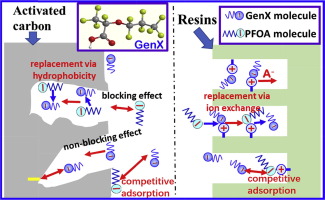Chemical Engineering Journal ( IF 13.3 ) Pub Date : 2019-01-28 , DOI: 10.1016/j.cej.2019.01.153 Wei Wang , Ayiguli Maimaiti , Huilan Shi , Rongrong Wu , Run Wang , Zelun Li , Delin Qi , Gang Yu , Shubo Deng

|
As a typical alternative to perfluorooctanoic acid (PFOA), perfluoro-2-propoxypropanoic acid (GenX) has been detected worldwide in aquatic environment and attracted great concerns recently, but their adsorptive removal from water is not clear. In this study, the adsorption behavior and mechanism of GenX on granular activated carbon (GAC), powdered activated carbon (PAC), anion-exchange resins (IRA400 and IRA67) were compared. The particle size of activated carbon (AC) affected the initial adsorption rate but exhibited little influence on the adsorption capacity for GenX. The initial adsorption kinetics of GenX on the three granular adsorbents (GAC, IRA67 and IRA400) followed the intraparticle diffusion-controlled adsorption. IRA67 had the highest adsorption capacity of 3.22 mmol/g for GenX, higher than IRA400 (2.78 mmol/g) and much higher than the two ACs (0.79 mmol/g). When GenX was co-removed with perfluorooctanoic acid (PFOA) in competitive system, the adsorbed amounts of GenX on the four adsorbents decreased significantly, and adsorbed GenX was replaced by PFOA with increasing time. The small adsorbent size could speed up the replacement process, and the polyamine group on the resins was more prone to producing this effect than the quaternary ammonium group. PAC was more suitable for GenX removal at low pH, while IRA400 was better used at high solution pH. The spent AC and resins were successfully regenerated in the ethanol and NaCl solution, respectively, and their regeneration efficiency was significantly enhanced in hot water. The adsorption mechanisms including anion exchange, electrostatic interaction and hydrophobic interaction were involved in the GenX adsorption.











































 京公网安备 11010802027423号
京公网安备 11010802027423号